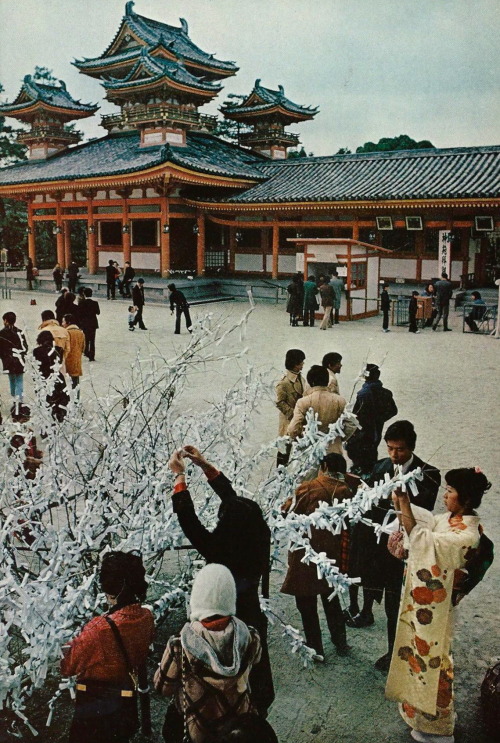#shintoism
June 6th - Fushimi Inari
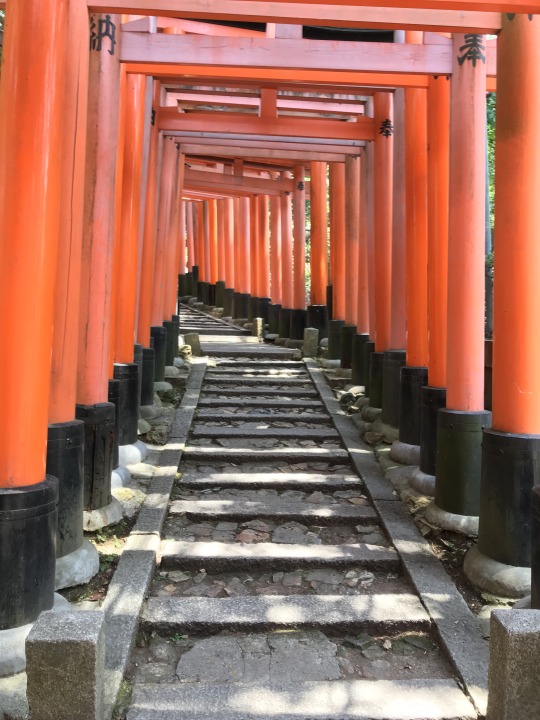
Rows of Torii at Fushimi Inari
Today we went to what I think is the most iconic thing to see in Kyoto - Fushimi Inari, or the mountain of ten thousand gates. We had the option to leave at 7am or 9:30, and although I voted for 7 (otherwise its impossible to get the photos everyone wants), 9:30 got the majority. I started my morning at 7:30 to help clean up from Lord of the Rings night a few doors down, and then we headed over to the shrine.
From the moment we got off at the stop for the shrine I could tell it was going to be a good excursion. The station was decorated with foxes, and Inari sushi was offered at a small stall. Fun fact - Inari sushi is named because fried tofu is apparently a favorite food of foxes. We headed up to the shrine, which was super impressive. There were statues of foxes everywhere, and much of it was painted in the red-orange color meant to ward off evil spirits. We started up the trail to the summit, which began with huge torii one after the other and also a million people crammed in together. As we descended, though, the people grew less and less and I was able to get one picture without other tourists in the shot.
The ascent itself wasn’t nearly as bad as Mt. Takao in Tokyo. Everything was paved and had stairs, and the angle of elevation was much less steep, save one or two stretches. We met another group back down the mountain and headed home. Even though climbing wasn’t bad, it was still really hot today so I really needed a shower. It’s 3:30 now, and I have a few things I want to get done. I need to scope some stores to get my brother the things he wants, and tomorrow is Seth’s birthday so we’re all going to do something for him tonight.
Professor Smith mentioned today that we should try to do as much as we can while we’re
Academic Reflection
The reading for today was about Inari, and the history surrounding the shrine and god/goddess. One thing I thought was really interesting was reading about how the shrine adapted after the separation of Buddhism and Shintoism by the Meiji government. Inari has been
Another cool thing was just how different Inari is seen at different levels. It is even debated whether or not they are a man or a woman. Priests believe that Inari was not a fox, and used them simply as messengers, but it is a common belief of the average shrine goer that Inari is, in fact, a fox. It was fun walking through the throngs of people and knowing that they all came from different backgrounds and believed different things, but still were brought together in worship and to see the beauty of the shrine.
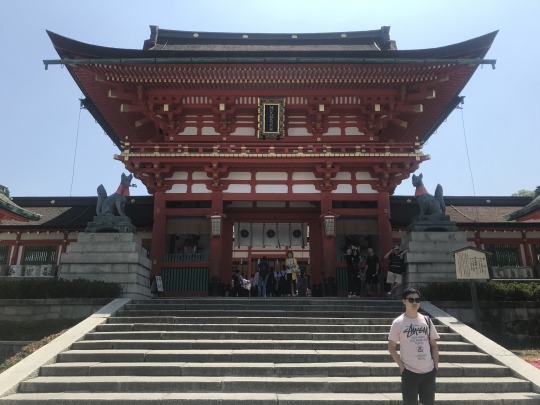
Outside of Fushimi Inari Shrine

View of Kyoto from an outlook near the summit
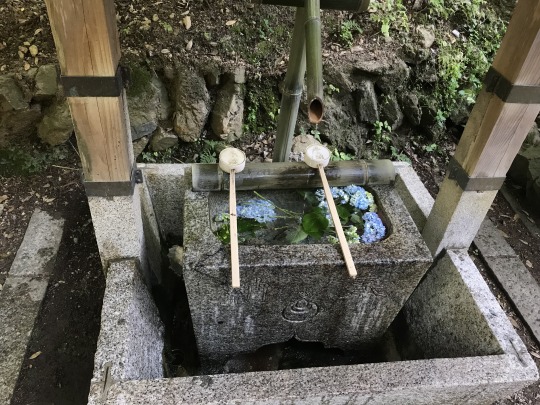
This fountain is used to purify you before you enter a shrine. This was next to a small one on the way up, but it had these pretty flowers in it and I liked it a lot
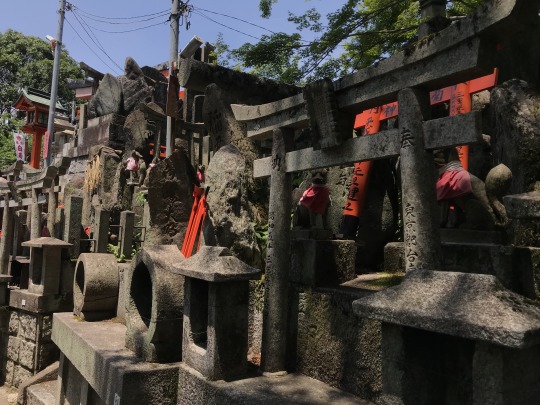
Some paths along the way had these arrays of tiny stone torii with fox statues around them
May 31st - Travel to Kyoto

Shinkansen at Kyoto Station
Today I was so sick that most of today past in a blur and I didn’t take as many pictures as usual. When I got dinner with Seth and Austin, I thought Austin said ‘sam’ instead of ‘one of us,’ and I also called Seth Ian. My head feels heavy and dizzy, and I have a dripping nose like nothing else. So, obviously, the train today was an absolute blast. We all got our shinkansen, or bullet train, tickets, but when I went through the gates the machine ate mine. I had to wait while the attendants got it out, but by that time there were only 10 minutes until the train. Maggie, one of our group leaders, and had to run around the platforms to find the train. We ended up going the wrong way and having to rush back, making it to the train minutes before everyone boarded.
I sat in between Valerie and Austin on the train, and honestly, don’t remember much of it. The train goes up to 300mph, but it’s so smooth that you can’t really feel it. I played started valley for a while, and then just knocked out. I was originally sleeping against the chair, but I guess at some point I slipped down against Austin because when I woke up there was snot all over the shoulder of his shirt (sorry Austin). Then, I read a little bit of a fantasy book over his shoulder, and then we were there in what felt like no time.
If Tokyo is the New York of Japan, Kyoto is
After arriving, I went to a pizzeria with Seth and Austin, and we met Summer, Valerie, and Amaya there. We walked around the main shopping center for a while, and I found a bunch of cute places I want to check out later.
Academic Reflection
Our reading today was on the history of the shinkansen. The trains faced a lot of resistance initially, due to the insane amount of money needed to create the tracks. Additionally, it causes weird changes in population density, which causes problems in the past. This was noticeable in that the platforms for bullet trains were across the station from any other trains, as old tracks can’t be modified for a bullet train, new ones need to be built.
The train passed through mainly sparsely populated areas, but every time there was a stop the city would suddenly bloom before us. This was a clear representation of how the shinkansen and city growth cannot be separated - they both rely on each other. One thing I noticed is that we didnt pass through much farmland, and I dont know if this is becuase of the specific line or becuase the line was so disrupted by the line that they failed afterwards, or maybe becuase I just slept throught that scnenery.

Floor mats and short dining table, with tatami floors, at the new house

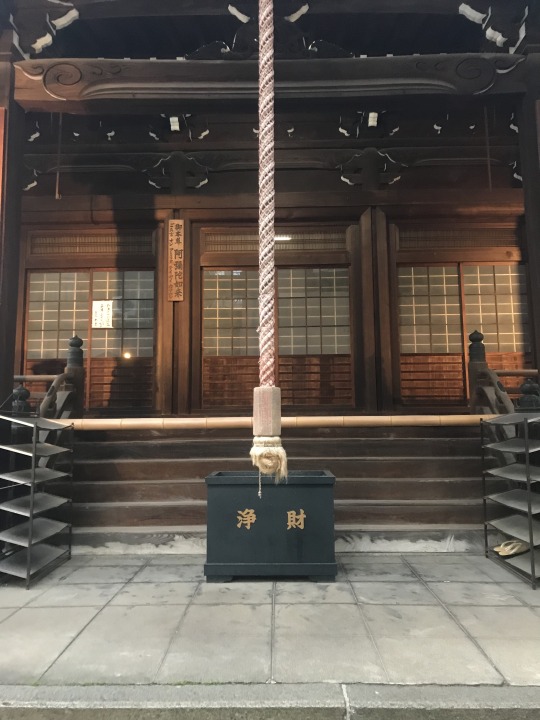
Shrine found in the mall near our house at Kyoto
May 29th - Ueno Park / Akihabara

Park at the Tokyo National Museum
This morning we had the opportunity to sleep in a little, and we didn’t meet until 10. We walked about 10 minutes to get to Ueno park, which was full of beautiful architecture and nature. There was a shrine with multiple torii, much like the famous one in Kyoto, but on a smaller scale. There was also a lake full to the brim with koi, and a shrine used by the shogun to show power and wealth. It differed from other shrines in the area because it was carved with many small details and gold plated, whereas others are more simple.
We walked to the Tokyo National Museum and went through an exhibit on the history of Japanese art. We got to see
After we were done, we headed to Akihabara. As we live in the area, many of us had already seen the area before, so we didn’t stay for long. One thing I did find interesting was walking down side streets of the old electronics stores, as the manga and anime capital of the world started as a meager electronics district.
I ran over to Ikebukuro afterward to watch a planetarium show with some friends and went out to karaoke for the first time. it is very different from American karaoke bars - instead of one stage in the restaurant, each group of patrons gets a small room that they can order food and drinks
Academic reflection
We only had one reading last night, on otaku culture. One thing the reading mentioned was that otakus generally switch from the consumer to the creator as a way to take ownership of their fictional worlds. While in Akihabara today we passed a store meant for people to sell their own anime.
It was also interesting that while walking around the main street, we were surrounded by media from all sides. Large flashing lights, posters for anime, maids on corners of streets advertising their cafes. It is easy to see how for some, this can become an entire lifestyle. These people, who ‘failed’ to make the transition between child and adult, have built such a fantastical world that I think it can be argued they have pushed the progression of this portion of the city more than many ‘adults.’

Unlined summer kimono at Tokyo National Museum


Shrine at Ueno Park

Sooooo many koi fish

Long chain of torii at Ueno Park
May 25th - Imperial Palace / Yasukuni Shrine

Koi fish in the Imperial Palace gardens
Today was another rough night. I don’t know if I can call it jet lag anymore because it’s been a week, but I still haven’t slept in long enough to hear my alarm. Today was the first time I didn’t do the readings the night before - we usually have a bit of time in the afternoon so I figured that I would do it before the blog post tonight - but it definitely hurt my understanding of what was going on.
We started the day going to Tokyo station, which was straight out of an early 1900′s movie. The district holds a lot of large corporations, as well as the government, but I was still shocked by the amount of space the could exist in such a tightly packed city. We walked to the imperial palace, but we couldn't go inside because its where the emperor and his family stay. Instead, we walked around the gardens, which were full of azaleas bushes in bloom. We saw some of the guard houses that would have been used in the Edo period and walked up so many slopes. I thought my shoes were broken in, but the angles that I had to walk made sure I still got blisters.
The Yasukuni Shrine was close by, so we headed there after finishing up at the palace. This place is rather controversial, as many who died in WW2 are enshrined here. Additionally, as it is a Shinto shrine, there are issues with the constitutionality involved in the mixing of church and state. The shrine was very different than the Meiji Shrine, which I will address below, but I was glad to be out of it when we did. I don’t know if it was the feeling of the soldiers still there or the strict air of the guards, but it was a rather ominous place to be.
After the shrine, I got udon with friends, hung out at home for a bit, and did some shopping at Shibuya. I finally got a change purse, so I can easily reach my coins. I hope it will make my mornings a little easier when I need to pay for my coffee.
Academic Reflection
The Yasukuni Shrine is not so much a religious place, regardless of the identification with Shintoism. Being there was a completely different experience from the Meiji shrine of before - there were guards everywhere who seemed to always be watching us, the ema area was much smaller, and there were no pictures of the shrine itself allowed. I felt more like I had walked into a museum than a religious area, and I can see how more conservative politicians would strive to achieve this. The shrine functions more as a political monument than as a shrine, so trying to get the prime minister to be able to visit seems much more approachable when the shrine is unapproachable.
Additionally, the reading went over the lack of patriotism in Japan. As we talked about at Musashi, the Japanese are much more likely to say that they are happy with the safety and nature of their country than they are to say that they love it simply for existing. As I walk around Tokyo, this can be seen in several ways. There are no Japanese flags to be seen, except for some I saw outside of Tokyo station, but even these were next to American flags. Additionally, many of my young Japanese friends do not have the same vigor when talking about Japan as Americans do talking about their own country. It would be interesting to see how this would change should Japan ever become more conservative and

Guardhouses at the imperial palace (not still in use)

Azaleas in the imperial palace

Compass pointing North at the Imperial Palace

Torii at the Yasukuni Shrine

Udon!
May 19th - Asakusa / Tokyo Edo Museum
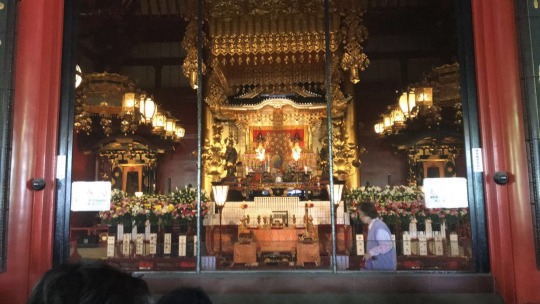
Inside of the Asakusa Temple
Today started super early - I woke up at 3am and couldn’t get back to sleep. From my window I got to see the sunrise at 4:30, and I finished the first set of readings, so it wasn’t all bad. I met up with friends for breakfast, and then we had a short informational meeting about the program. Then we got our subway cards and headed to the Asakusa Buddhist temple. The front of the temple was filled with tourist-centric stores. We got our fortunes for 100¥ - if a bad fortune is received, you can tie the paper up around the temple to counteract it. Then entered the temple. Inside there was a mass of people going to the front to throw a coin in and bow. We had a bit of time to ourselves to look at the shops and grab lunch, and then we made our way to the Tokyo Edo Museum. Here, we first saw small replicas of the palace and artifacts that they would use, such as a palanquin. Downstairs held exhibits about the commoners of the time. The woodblock printing area was super cool, and we got to see how many steps there were in the process. There was also a section on modern Tokyo, including the introduction of cars, newsprint, and Western architecture. I barely made it home I was so tired, but I plan to pick up some groceries and head to bed soon.
Academic Reflection
The readings for today focused on Buddhism and the Tokugawa period of Tokyo. The Porcu piece touched upon the separation between Buddhism and Shintoism, so it surprised me when a Shinto event occurring outside the temple. Becuase Japan is entering a new era, the Shinto group in the area was sharing the space to celebrate the event. I thought that the two groups would be more separate, but it appeared as though they had a good relationship. Many people, whether they were there to pay their respects at the Buddhist temple or for the Shinto activity, were excited to see the activities as they passed down the center of the street.
Additionally, one of the readings focused mainly on woodblock printing. This allowed for a mass print culture to exist in Tokyo much earlier than in many parts of the world and is one of the reasons Tokyo in this time is considered pre-modern. From this, literacy rates were higher as books were made, and woodblock art was very popular. There is something about the woodblock printing that I feel needs to be seen to understand. I, along with many of my peers, was under the impression that the woodblock was one carved piece, and the prints were later painted to add color. However, at the museum, we saw a total of 8 wood carvings used to create one print. Each one creates a different layer of color and depth on top of the last one.
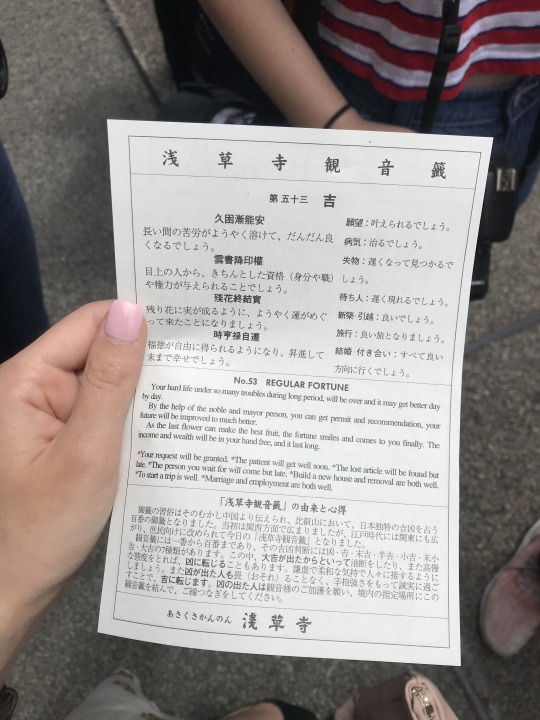
My fortune, received at Asakusa.

A demonstration of woodblock printing and the steps behind it at Tokyo Edo Museum
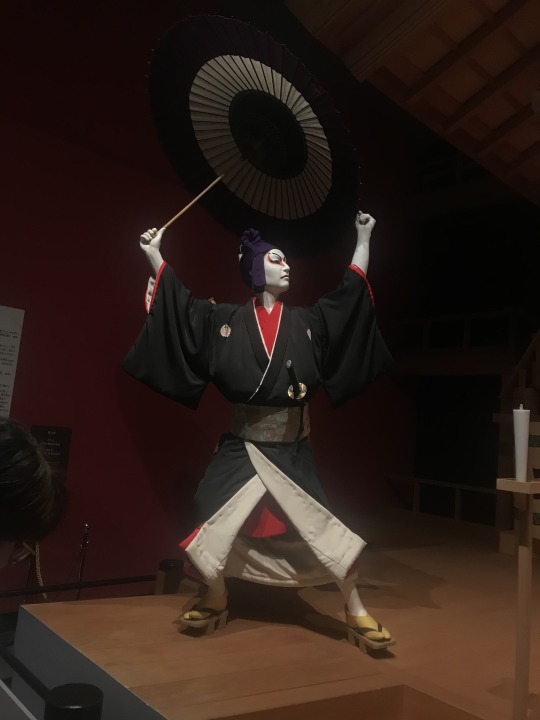
A replica of a Kabuki actor
Bishamon or Bishamonten from “Seven Gods of Fortune” in Shintoism is the typical “strong woman” trope character in a Shonen anime called Noragami: she is angry, she is beautiful and conveniently buxom for fans to drool over her. Termed by Yato as “ugly broad” Bishamon is fierce and coarse. However, she is not only that: she has a caring and nurturing side which almost caused her demise once and put her in danger over and over again. So this is my take on Bishamon and why she is the Eastern archetype of “Warrior Mother Goddess” instead of her Shinto persona.

First of all, let’s look what Bishamon actually is in the Classic Shinto religion. In Japan, Bishamonten (毘沙門天), or just Bishamon (毘沙門) is thought of as an armor-clad god of war or warriors and a punisher of evildoers. Bishamon is portrayed holding a spear in one hand and a small pagoda in the other hand, the latter symbolizing the divine treasure house, whose contents he both guards and gives away. His (because Bishamon is a male in Shintoism) legend derives from the Hindu Demigod “Vaisravana” or “Son of Vishrava”, who is known as Kubera the God of wealth. Both Vaisravana and Bishamon are associated with material fortunes and Bishamon is really a fierce version of Vaisravana, a well-fed, content and rather gluttonous demigod.
But how a god like Bishamon gets transferred in Noragami to a woman? It could be a design choice by Adachitoka to create a contrasting female character who could meet Yato in a more Godly plane. But I can see some clear Hindu influence in Bishamon’s design. She is inhumanly beautiful, fierce, perfect body and with rapunzel length hair. Her design is very similar to the Warrior Goddess Durga. In the “Meditation of Durga” she is described as
“the one with great length-ed dreadlocks in her head…whose face is beautiful like the full moon, whose complexion is as fair as flax seed flower…whose beautiful teeth sit on her full lips, whose full breasts hold the elixir of immortality*– (Meditation of Durga, verse 1-3)
The physical description of Durga has uncanny similarity with Bishamon. the Goddess is also called “nabayouvana sampannang, sarbabharana bhushitang” (who is young and clad with fantastic jewels). Bishamon may be young and beautiful but she does not wear any eastern jewels: she is rather clad with her regalias posed as weapons, navigation and clothes; thus it isn’t far off.

It is not only the superficial physical appearance that are similar with Durga and Bishamon; they also share some character similarities. The traditional Bishamonten is not known to have a mount or Divine Familiar, Bishamon in the anime on the other hand does a divine familiar in the form of mount: Kuraha, who takes the shape of Lion and can travel in the air. This is an iconic similarity with Durga, whose divine mount is a lion. In “hymns of Gandhesvari” Durga (or her Gandhesvari form) is described as “Simhasta” (the one who rides a lion). Durga is also known as “Simha vahini” (she whose vehicle is a lion). The Bishamonten is known to carry only one weapon, a spear, but Bishamon in Noragami has or carries multiple weapons because she has multiple regalia. In the “Meditation of Durga” the goddess is known to carry a goad, bow and arrow, executioner’s sword, discus, conch, mace, shield, rosary and the trident. Bishamon too carries multiple weapons: whip, guns, knife long machete etc, just like Goddess Durga herself. One part of Durga’s weapon is “Aveda barma” or the “impenetrable armour” forged by the ironsmith of the Gods, Vishwakarma (the forger of the universe). Bishamon wears a full blown armour by her regalia Aiha when the Ebisu-crisis occured and she had to journey to underworld.

Now, in the parallel of two warrior goddesses who seem to be far from society’s idea of ideal femininity, where does the nurturing part fit? According to the Hindu mythology Durga is only a fragment of the ideal femininity: the rightful rage of “Adi Shakti” (Ancient Energy), the Female mother goddess. (Excuse my jargon) in the “Durga Saptashati” of Rigveda, the Goddess is described as “mother of all creation” (verse no 3) and at the same time she is described as “creator, sustainer and destroyer of the world” (verse no 4) of which she is the Mother. Bishamon has an extensive collection of regalia: she does not discriminate who is weak or who is useful, she takes everyone in as her own according to Noragami Wiki:
“She willingly accepts any wandering and troubled spirit, useful or not, and adds them to her family. “
She and her Shinkis live in Takamagahara which is the universe on its own, so she is the guardian and mother of her Shinkis in a way. Takamagahara is situated in a place which has golden hued galaxy as the backdrop of the sky. The form of Durga which alludes to the primeval Female Goddess is called “Bhuvaneswari” (she, whose body is the universe). The shinkis or regalias derive strength from her divine existence and they exist in a palpable form because of her. It again alludes to “Devi Suktam” (the introduction of the Goddess) where is has been mentioned:
“ I am the Queen of the Universe; I give wealth to those who worship me. I am the all-knowing one and the prime one among the worshippable deities. I enter many bodies as the Soul, taking various forms and with different manifestations, in various ways. … That one who eats food, who sees, breathes, and hears whatever is said, he does all that only through me (my powers). Those who do not understand me, die. “ –(Devi Suktam, verse 4 & 5)
The sense of being center of the universe has brought a tremendous sense of loss and grief to the goddesses in many occassion. In the myths, when Goddess Parvati (the calm version of Durga) loses her child Ganesha, she assumes her rageful spirit again to destroy the universe that has taken her child from her. Bishamon has faced tremendous sense of loss and grief when she lost her “Ma” clan due to the malefic thoughts of the Shinkis–an action which blighted her tremendously. She too assumes a vengeful spree towards Yato, who allegedly slaughtered her “Ma” clan.
In short Bishamon is a great representation of motherly strength in anime field: the term “mother” often evokes a sense of tenderness, security and comfort, but it has been proven in the ancient myth that bringing life into the world and the sense of protectiveness towards life is the most powerful energy of all: it can make an break everything in existence and when the motherly tenderness is challenged it can manifest in one of the most destructive forces in the world. Thus the “ugly broad” “stern powerhouse” persona is only skin deep. The essence of Bishamon is far greater and more empowering.
* In ancient India, full breasts of a woman, which are swollen with milk was granted as a symbol of motherly power, nourishment and comfort. A woman with moderate breast size or small breast size were considered equally beautiful. In fact talking about sexuality in religious and secular discourses by scholars and sages were acceptable. It has no sexual connotation whatsoever. Please don’t perverse it in any sense.
…
wow that’s a lot, now tags (although I have no evidence that they like Noragami)
:@sidd-hit-my-butt-ham@yanderebakugo@kurokonbscenarios@kurokonobasket@kurokonoboisket@art-zites@idinaxye@sp-chernobyl@strawbe3ryshortcake@reservethemoon@rilnen@a-shy-potato@thirsthourdemon@animebxxch@edagawasatoru@akawaiishi-blog@reinyrei@chloe-noir@theswahn@ahobaka-trash@jeilliane@trashtoria @scarlettedwardsposts@quirkydarling@ghostieswaifu@levihan-freaks@hope-im-spirited-away@yves0809@marshiro1101 @bubziles @heartfullofknb@kit-kat57@akichan-th
Heian Shrine in Kyoto, Japan. For good luck, celebrants buy fortunes scratched on white paper and tie them, like blossoms, to bare-branched trees
National Geographic | June 1976
Post link


